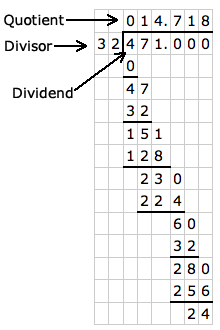Long Division Calculator with Decimals
Calculator Use
Do long division with decimal numbers and see the work for the calculation step-by-step. Enter positive or negative decimal numbers for divisor and dividend and calculate a quotient answer.
How to Do Long Division with Decimals
- If the number you're dividing by has a decimal, move the decimal point all the way to the right counting the number of places you've moved it to. Then move the decimal point in the number you're dividing the same number of places to the right.
- Insert a decimal point in the quotient (answer) space, exactly above the decimal point in the number under the division bar.
- Divide until the remainder is zero, or until you have enough decimal places in your answer. You can also stop if the remainder repeats because this indicates that your answer is a repeating decimal.
Calculate Decimal Places for a Quotient Answer
How far do you want to calculate the decimal places for the answer? Here are some examples:
- 31 divided by 16 = 1.937500 calculating to 6 decimal places
- 31 divided by 16 = 1.937 calculating to 3 decimal places
- 22 divided by 15 = 1.466666666 calculating 9 decimal places
- 22 divided by 15 = 1.466666 calculating 6 decimal places
- 22 divided by 15 = 1.466 calculating to 3 decimal places
Note that this is not the same as rounding to a specific number of decimal places. For example, 22 divided by 15 = 1.466 when calculated to 3 decimal places because you stop once you reach the third decimal place. On the other hand, 22 divided by 15 = 1.467 when rounded to 3 decimal places. In order to round to the third decimal place you must calculate to at least the fourth decimal place so that you know how to round the third decimal place. See our Rounding Numbers Calculator for more information.
Also see our Long Division with Remainders to see the work for long division with remainders.
Parts of Division
For the division problem 471 divided by 32:
- 471 is the dividend
- 32 is the divisor
- 14.718 is the quotient calculated out to 3 decimal places

How to do Long Division with Decimals: Example
In this problem we divide 4.71 by 3.2 out to 3 decimal places in the quotient answer.
Since 3.2 is not a whole number move the decimal point one place to the right. 32 is a whole number. Do the same to the dividend and move the decimal one place to the right.
Since we are solving to 3 decimal places, add two trailing zeroes to the dividend.
Insert a decimal point above the division bar, directly above the new decimal position in the dividend.
Since 4 divided by 32 is not a whole number, the first quotient digit is 0.
Multiply the divisor 32 by the quotient 0 to get the product 0. Subtract 0 from 4 to get the remainder 4.
Insert 1 in the quotient. To find the remainder, multiply the divisor by 1 and subtract the product 32 from the second dividend 47. The remainder is 15.
32 goes into 151 four times. Put a 4 in the next place in the quotient and multiply 32 by 4 to get 128.
Subtract that product from 151 to find a remainder of 23.
32 times 7 is 224.
230 minus 224 leaves a remainder of 6.
32 multiplied by 1 is 32.
Subtracting 32 from 60 leaves a remainder of 28.
Wikipedia: Long Division